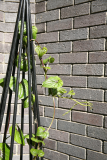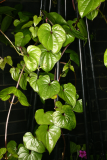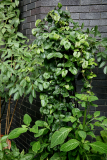Additional notes (click to expand)
Commemorative
It was named for Pedanius Dioscorides (Diuscurides) of Anazarbus (AD 40–90), a Greek physician and herbalist who practised in Rome. He was born in Anazarbus, in the Roman province of Cicilia, during the reign of Tiberius or Caligula, and was a contemporary of Pliny the Younger (AD 61–112).
He studied pharmacology in Tarsus under the teacher Arius/Areios, to whom he dedicates his book, De materia medica. He lived ‘a soldier’s life’ – viz an itinerant one – travelling through the Greek-speaking part of the Roman Empire, Sicily, southern Italy and possibly into Gaul. His book remained the main source of herbal medicinal information for the next 1,600 years. It was
translated into Latin and Arabic, being copied by hand for 1,400 years. It had no illustrations and it is diffi cult to be certain what plants he was writing about. In 491 the Vienna Dioscorides, also known as the Anicia Juliana codex, was produced, a manuscript with paintings of what contemporary writers believed were the plants of Dioscorides.
Oakeley, Dr. Henry. (2012). Doctors in the Medicinal Garden. Plants named after physicians. Royal College of Physicians.
link
The historical significance of the genus name, Dioscorea, lies in its commemoration of Pedanius Dioscorides of Anazarbus (40-90AD), the Greek physician and herbalist, who published the first systematic account of the medicinal nature and uses of plants in 50-70AD – the five volumes of De Materia Medica, the precursor and in many ways still the basis of modern pharmacopoeias. The name was first applied by Charles Plumier (1703), the French explorer, botanist, and monk of the discalced order of the Minims, in 1703. Plumier discovered it on one of his expeditions to the Antilles as botanist to the French king, Louis XIV, in 1693 and 1695.
Oakeley, HF. (2016). A Garden of Medicinal Plants. The Royal College of Physicians.
Medicinal
Dr Henry Oakeley video
Videos from the garden
link
Prescription only medicine: steroids, oestrogens etc.
Russell Marker (previously involved in developing the octane rating system for petrol), Carl Djerassi (polymath chemist, writer and benefactor), Frank Colton and George Rosenkranz showed how to make large quantities of the natural steroids and chemical analogues with better properties, from chemicals obtained from plants. The first successes came from converting stigmasterol, a waste product from soy bean processing, into cortisone; soon followed by use of diosgenin from the Mexican yam and later hecogenin from sisal waste to manufacture progesterone and other sex steroids. Derivatives with better therapeutic properties were developed subsequently, such as the fluorocorticoids, and the contraceptive mestranol and norethisterone. They have come into very wide medical use. Plant-derived materials are still the basis of steroid industries in many countries although the modern trend to using biochemically engineered lower organisms for industrial production of chemicals is displacing both collection from the wild and the harvesting of cultivated plants. At least one hundred million women now take a contraceptive pill to try to control the population explosion that that this plant contributed so much to causing in the first place.
Oakeley, HF. (2016). A Garden of Medicinal Plants. The Royal College of Physicians.
Nomenclature
Previously grown as Dioscorea batatas which is a synonym.
http://www.plantsoftheworldonline.org/
Other use
In 1988 Benjamin Johnson was stripped of his 100metre Gold Medal for use of the anabolic steroid stanazolol which can be made from yams.
DeSwiet, Michael. (2012). Plants and the Olympic Games.
link
Geographical distribution
- Asia-Temperate, China
- Asia-Temperate, Eastern Asia, Japan
- Asia-Temperate, Eastern Asia, Korea
- Asia-Temperate, Eastern Asia, Taiwan
Dioscorea polystachya Turcz.
Family: DIOSCOREACEAEGenus: Dioscorea
Species: polystachya Turcz.
Common names: Chinese Yam
Distribution summary: China, East Asia
Habit: Perennial
Hardiness: H4 - Hardy; average winter
Habitat: Rocky slopes
Garden status: Currently grown
Garden location: Wolfson Terrace (T)
Flowering months: September, October
Reason for growing: Commemorative, medicinal, prescription only medicine
.JPG)
.JPG)


